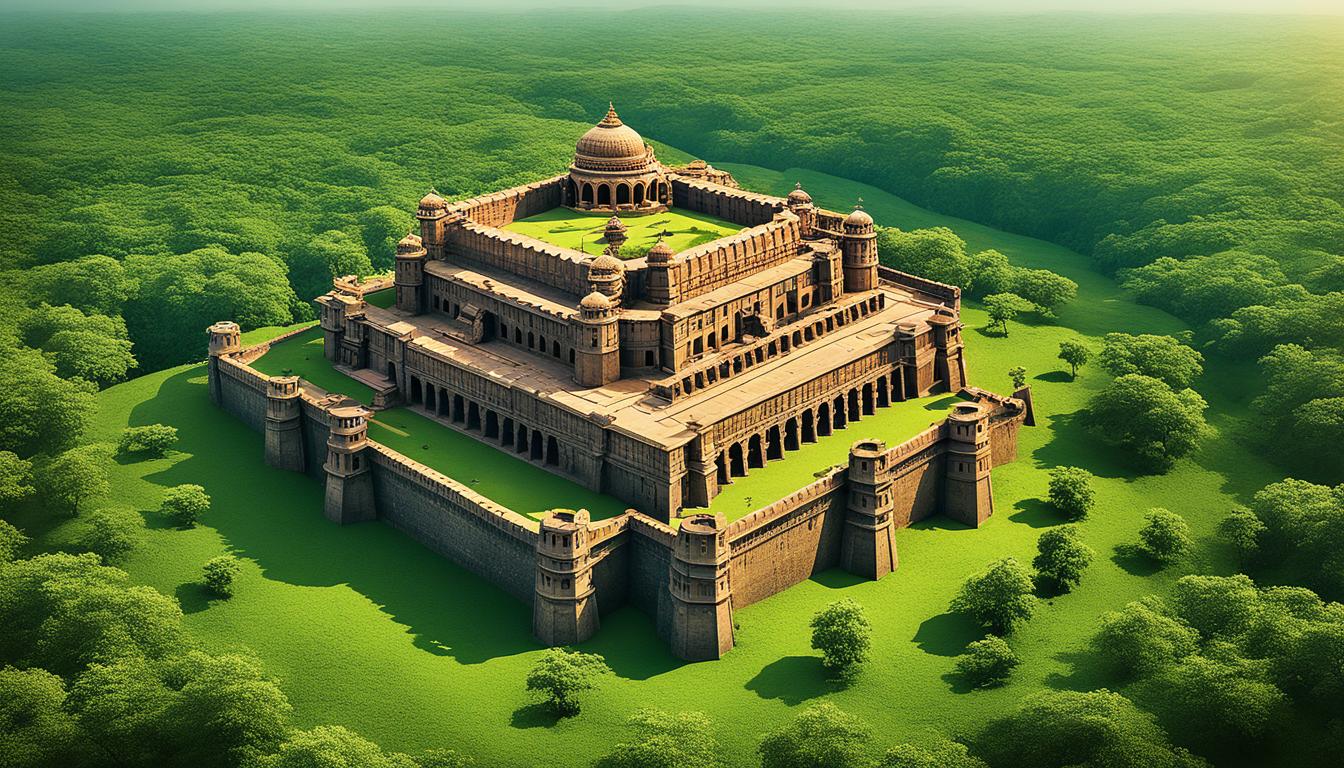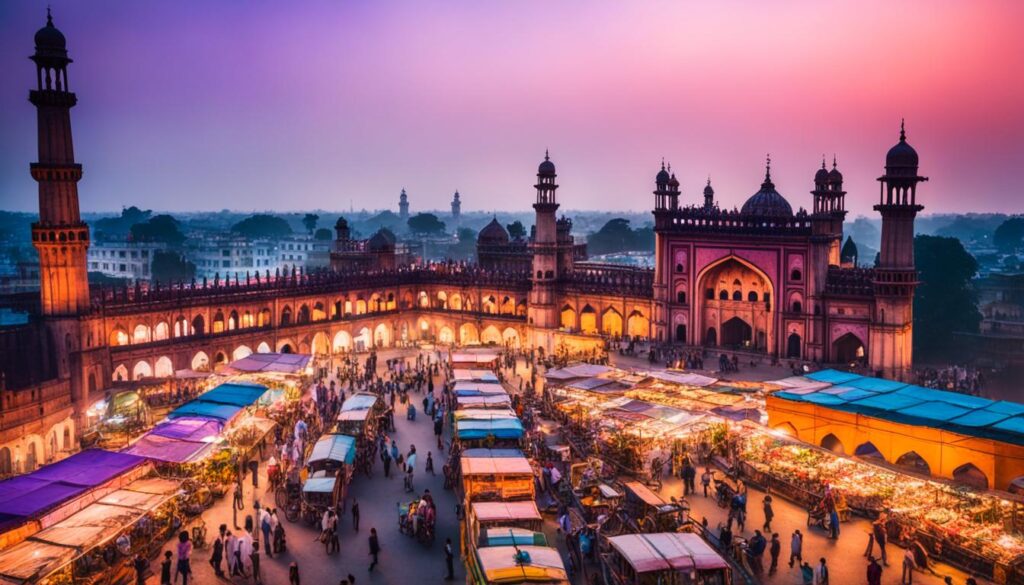
Exploring Places of Indian Cultural Heritage
Did you know that India is home to over 38 UNESCO World Heritage Sites, making it one of the most culturally diverse countries in the world? From ancient temples and palaces to mesmerizing historical landmarks and architectural wonders, India’s rich heritage attracts millions of travelers every year.
When it comes to experiencing the true essence of Indian culture, these places of Indian cultural heritage offer a window into the country’s vibrant past. Cultural tourism in India goes beyond its picturesque beaches and luxurious resorts, delving deeper into the fascinating history, art forms, and cuisine that contribute to its cultural identity.
In this article, we will take you on a journey to explore some of the most iconic and enchanting cultural landmarks in India. From the Golden City of Amritsar in Punjab to the City of the Nawabs, Lucknow, and the cosmopolitan capital city of Delhi, each destination offers a unique blend of history, spirituality, and tradition.
Amritsar: The Golden City In Punjab
Amritsar, often referred to as the “Golden City,” is a vibrant destination in the state of Punjab, India. This culturally rich city is known for its historical landmarks, religious sites, and delicious Punjabi cuisine.
At the heart of Sikh culture lies the Sri Harmandir Sahib, also known as the Golden Temple. This magnificent gurdwara attracts millions of visitors every year, offering a spiritual experience like no other. With its gleaming golden exterior and serene ambiance, it is a sight to behold.
“The beauty and tranquility of Sri Harmandir Sahib truly captivate the soul. It is a place that welcomes people from all walks of life, fostering unity and harmony.”
Another significant site in Amritsar is Jallianwala Bagh, a poignant reminder of India’s struggle for freedom. This historical garden serves as a memorial to the hundreds of innocent Indians who lost their lives during the Jallianwala Bagh massacre in 1919. Visitors can explore the memorial and pay their respects to the brave souls who sacrificed their lives.
A visit to the Wagah Border is also a must when in Amritsar. Located at the India-Pakistan border, this mesmerizing daily ceremony showcases the extravagant display of military drills and flag-lowering ceremonies. It is a symbol of patriotism and a testament to the bond shared by the people of India and Pakistan.
Amritsar is also known for its unique residential units called katras. These narrow lanes were designed to provide protection during times of war and are an integral part of the city’s architectural heritage.
For those seeking spiritual solace, Amritsar offers several other religious places such as the Durgiana Temple, Akal Takht, and Mata Lal Devi Temple. Each site has its own distinct charm and significance.
Immerse Yourself in Punjabi Cuisine
No visit to Amritsar is complete without indulging in the mouthwatering delights of Punjabi cuisine. The city is renowned for its delectable offerings, from the famous Amritsari Kulcha, a traditional Punjabi stuffed bread, to the refreshing Lassi, a yogurt-based drink.
The flavorful spices, the rich curries, and the warm hospitality make dining in Amritsar an unforgettable experience. Immerse yourself in the culinary wonders of Punjab and discover why Punjabi cuisine is loved worldwide.
Amritsar, the Golden City, offers a blend of cultural heritage, spiritual experiences, and culinary delights that make it a compelling destination for travelers. Whether you’re seeking a deep connection with Sikh culture, paying homage to history, or tantalizing your taste buds, Amritsar has something for everyone.
Amritsar at a Glance
| Popular Attractions | Religious Places | Cuisine |
|---|---|---|
| Sri Harmandir Sahib (Golden Temple) | Durgiana Temple | Amritsari Kulcha |
| Jallianwala Bagh | Akal Takht | Lassi |
| Wagah Border | Mata Lal Devi Temple | Butter Chicken |
Lucknow: The City Of The Nawabs
Lucknow, the capital of Uttar Pradesh, is a city steeped in history and known for its distinctive culture. It is often referred to as the “City of the Nawabs,” due to its association with the princely rulers who governed the region during the era of the Awadh dynasty.
In Lucknow, you will find a fascinating blend of architectural wonders, cultural landmarks, and delectable cuisine. The city’s rich heritage is evident in its magnificent structures, such as the Bara Imambara and Chhota Imambara.

The Bara Imambara, also known as the Asafi Imambara, is a grand monument known for its large vaulted hall and labyrinth called the Bhool Bhulaiya. It is a masterpiece of Mughal architecture and an iconic symbol of Lucknow’s cultural splendor. The Chhota Imambara, on the other hand, showcases exquisite craftsmanship and features a stunning silver throne and an awe-inspiring collection of chandeliers.
But Lucknow’s charms extend beyond its architectural wonders. The city is renowned for its traditional Lucknowi cuisine, which is a delightful fusion of Mughlai and Awadhi flavors. Indulge in mouthwatering dishes such as Galawati Kabab, Tunday Kabab, and Lucknowi Biryani, which are sure to tantalize your taste buds.
Popular Tourist Attractions in Lucknow
Aside from the Bara Imambara and Chhota Imambara, Lucknow offers a plethora of other attractions that showcase its rich heritage. Some of the must-visit places include:
- Rumi Darwaza: This imposing gateway is a symbol of Lucknow’s grandeur and serves as an entry point to the city’s bustling markets.
- Dilkusha Kothi: Built in the 18th century, this historic palace reflects a fusion of European and Awadhi architectural styles.
- Chhattar Manzil: This majestic palace was once the residence of the Nawabs of Awadh and now houses a museum that displays artifacts from that era.
- Husainabad Clock Tower: Standing tall in the heart of the city, this iconic clock tower is a symbol of Lucknow’s rich history.
- Satkhanda: Known as the “Tower of Seven Storeys,” Satkhanda is a historical tower that was initially planned to have seven stories but was never completed.
Experience the Essence of Lucknow
A visit to Lucknow is not just about exploring its architectural marvels and historical sites; it is also an opportunity to immerse yourself in the city’s vibrant culture. Take a stroll through the bustling streets of Chowk and Hazratganj, where you can shop for traditional crafts, exquisite Chikankari embroidery, and local delicacies.
Immerse yourself in the Nawabi hospitality and take home cherished memories of a city that has beautifully preserved its cultural heritage through the test of time.
Whether you’re a history enthusiast, a food lover, or simply seeking an authentic cultural experience, Lucknow will captivate you with its old-world charm and warm hospitality.
Popular Lucknowi Dishes
| Dish | Description |
|---|---|
| Galawati Kabab | A melt-in-your-mouth kabab made with finely minced meat and a blend of fragrant spices. |
| Tunday Kabab | Aromatic and succulent kebabs known for their unique spice mix and tender texture. |
| Lucknowi Biryani | A flavorful rice dish cooked with aromatic spices, tender meat, and fragrant saffron. |
Delhi: A Potpourri Of Different Cultures
Delhi, the cosmopolitan capital city of India, is a testament to the country’s diverse cultural heritage. With its rich historical past and vibrant present, Delhi is a melting pot of different cultures, traditions, and influences.
The city boasts a plethora of iconic tourist attractions that showcase its cultural heritage. The magnificent India Gate stands as a symbol of national pride and unity, while the Red Fort and Old Fort transport visitors to the grandeur of the Mughal era. Qutub Minar, a UNESCO World Heritage Site, is a towering masterpiece of Indo-Islamic architecture.
But Delhi’s cultural vibrancy extends beyond its architectural wonders. The city is home to numerous museums, art galleries, theaters, and cultural hubs that celebrate various art forms and performances. It offers a wide range of cuisines, from lip-smacking street food to gourmet delights, reflecting the city’s culinary diversity.
Throughout its history, Delhi has been influenced by a myriad of religions, dynasties, and rulers, leaving an indelible mark on its cultural tapestry. From the Rajputs to the Sultans, the Mughals, and even the British, each dynasty contributed to and shaped Delhi’s unique character.
For those looking to delve deeper into India’s cultural heritage, the nearby towns of Kurukshetra and Panipat offer fascinating insights into ancient history and legendary battles. With their own historical monuments and cultural attractions, these towns provide a perfect complement to the experience of exploring Delhi.
Source Links
- https://traveltriangle.com/blog/places-of-indian-cultural-heritage/
- https://www.tripbeam.com/blog/indias-4-best-cultural-heritage-destinations-in-2023
- https://www.happyeasygo.com/travel-blog/heritage/explore-the-cultural-heritage-of-india/

Leave a Reply